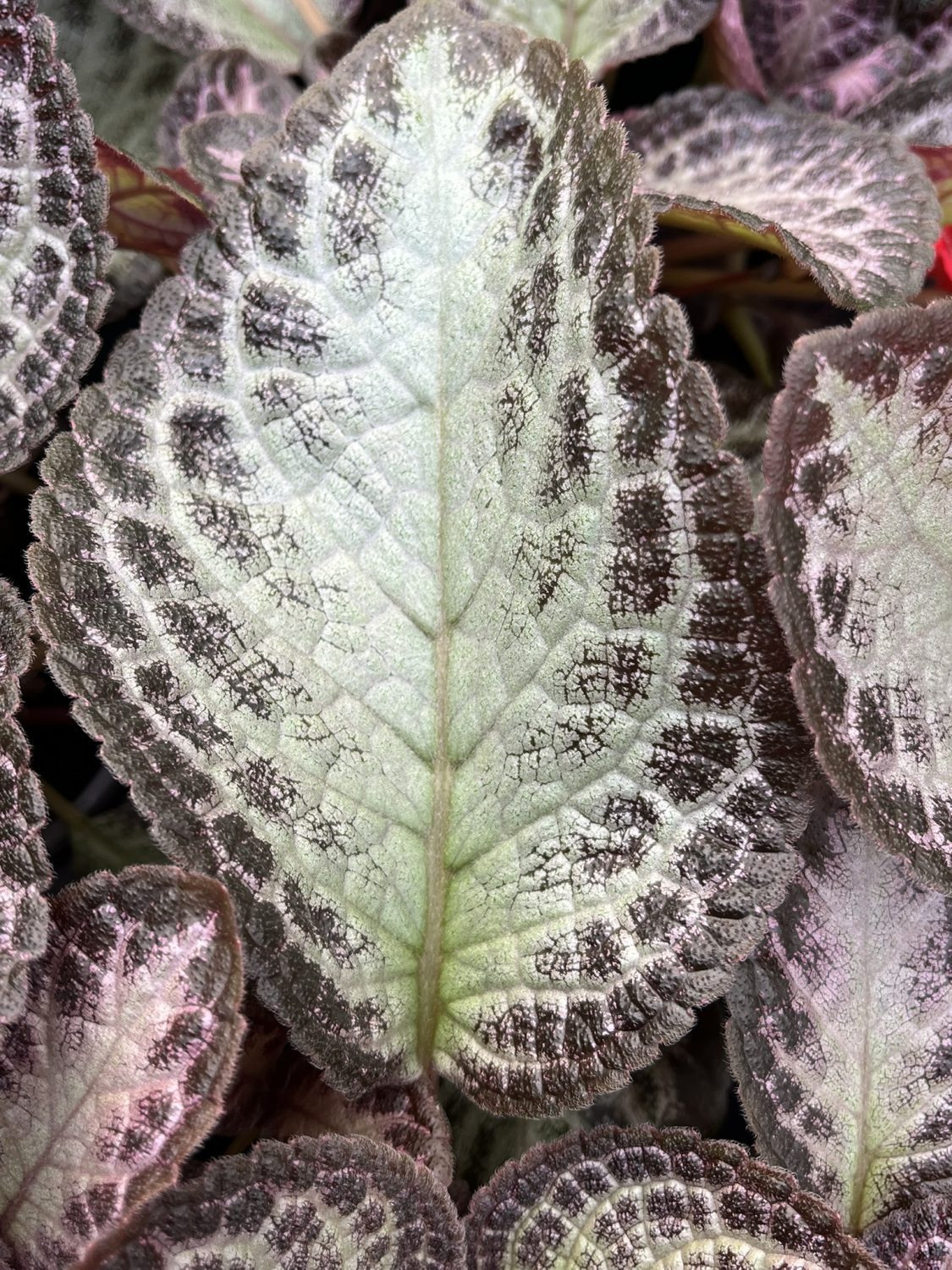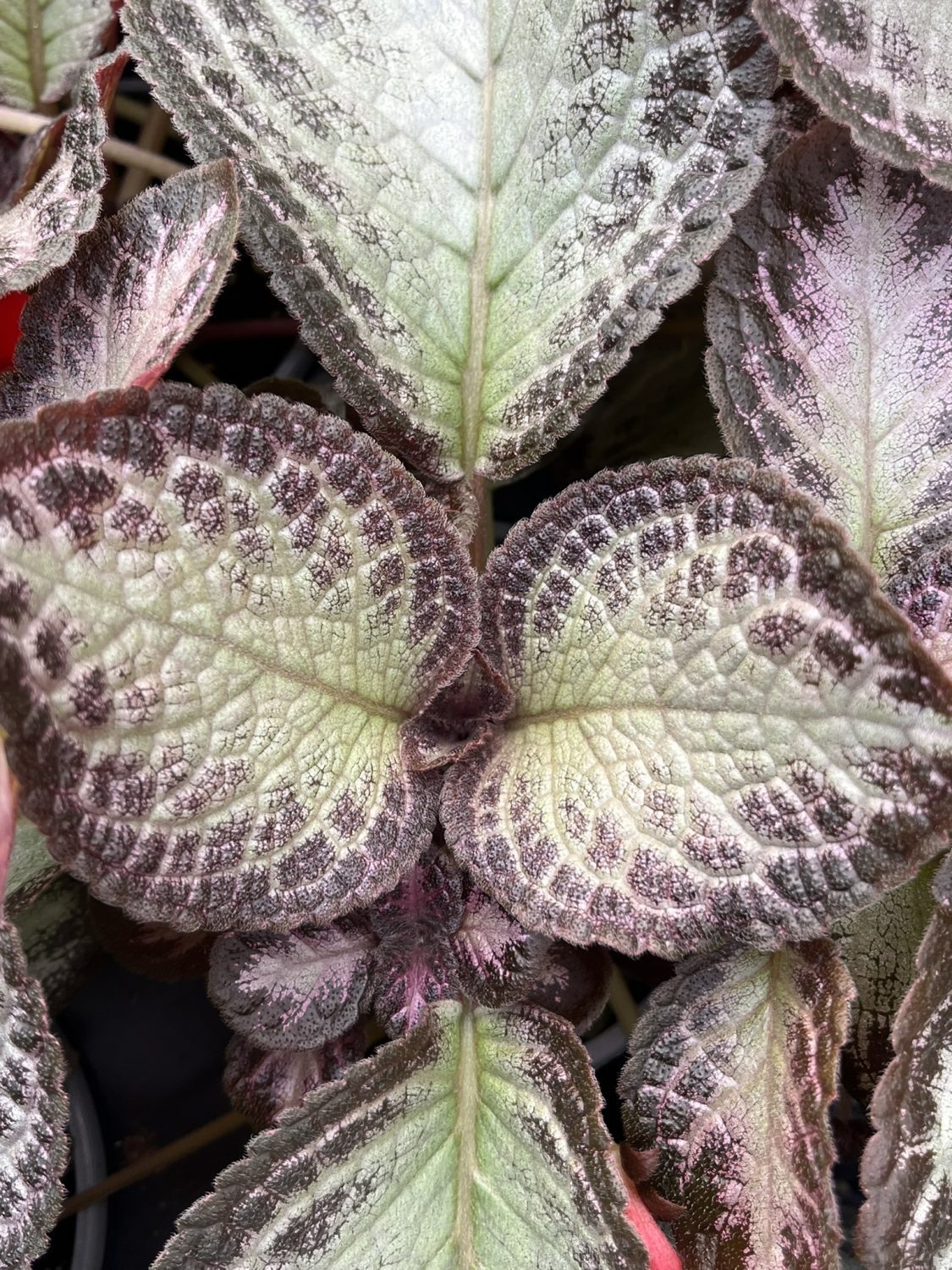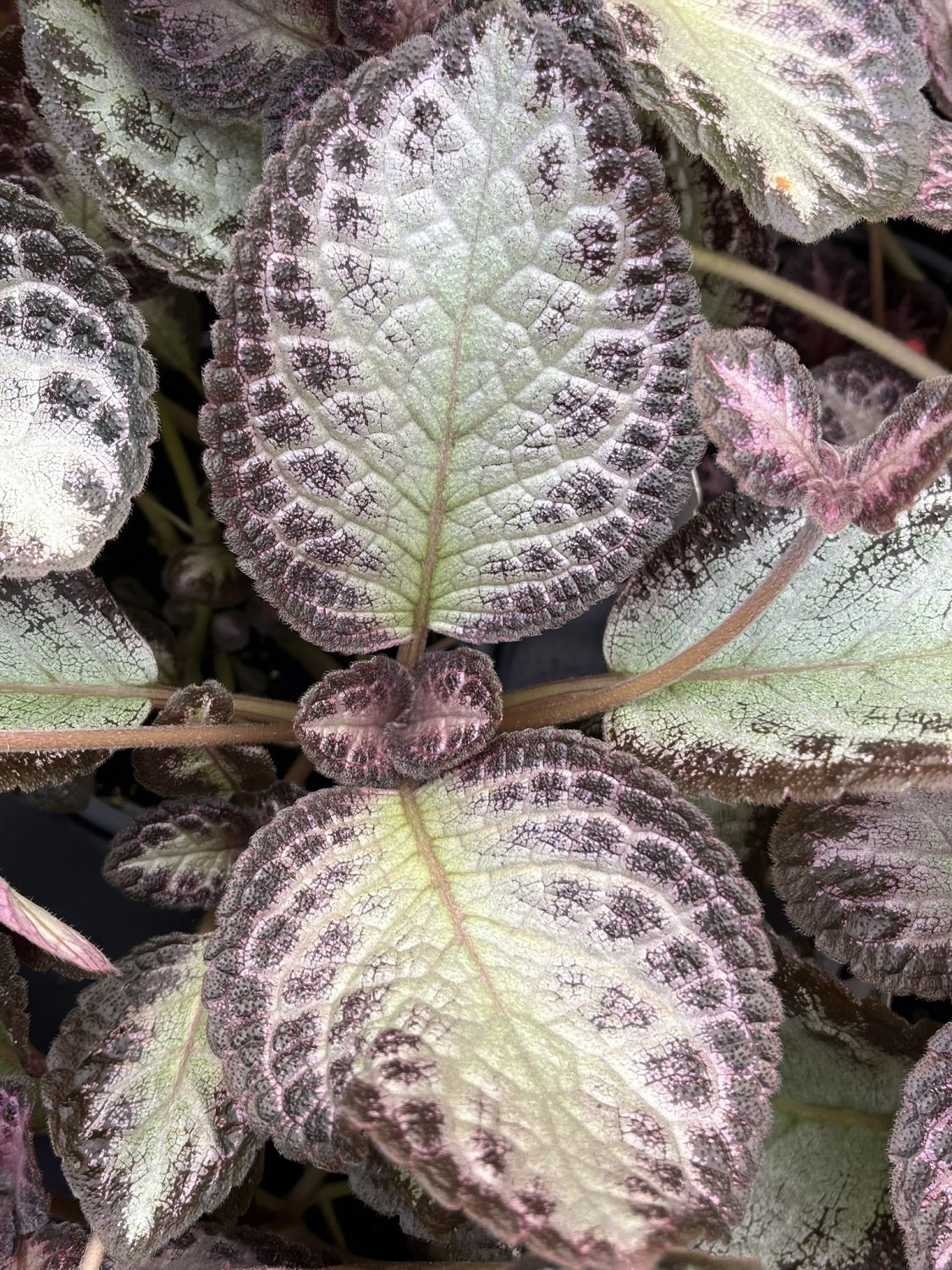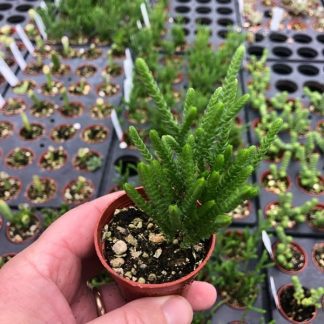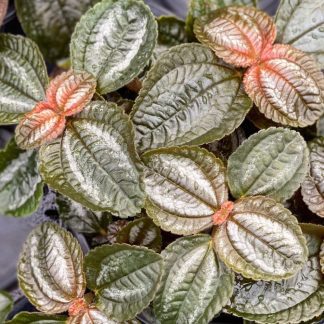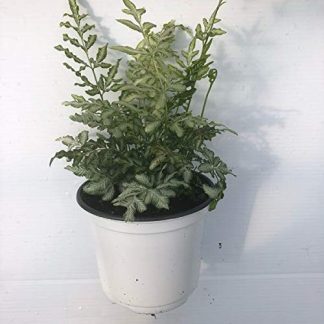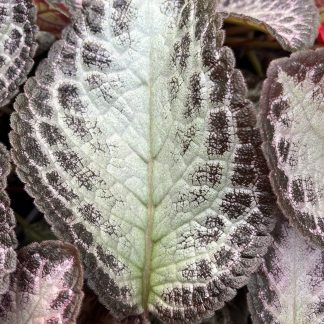Description
Episcia cupreata ‘Platinum’ (Flame Violet) — Silver Velvet Leaves, Low-Stress Care, Bright Little Blooms
Want a houseplant that looks rare but acts easy? Episcia cupreata ‘Platinum’, also called Flame Violet ‘Platinum’, brings cool silver foliage with deep green veining and a soft, velvety feel. The leaves shimmer like brushed metal. Slender runners spill over the rim and form baby plants, so one start can turn into a full, cushy mat. And the flowers? Slim, tubular blooms—often coral, orange, or red with sunny throats—that pop against the silver canopy.
In this friendly deep-dive, we’ll show you how to grow ‘Platinum’ with confidence. We’ll cover light, water, humidity, soil, potting, feeding, shaping, and quick fixes. We keep the pace calm. We keep the steps short. And we focus on real wins you can see on your shelf.
Why We Love ‘Platinum’
- Silver velvet foliage. Icy, luminous leaves with dark green veins and a soft nap.
- Trailing habit. Runners (stolons) root fast and fill a pot without extra effort.
- Compact size. Perfect for shelves, stands, and plant cabinets.
- Bright contrast blooms. Warm flowers pop against cool leaves for true “wow.”
- Beginner-friendly rhythm. Even moisture, gentle light, steady humidity—done.
In other words, we get drama from leaves and color from flowers. We get a generous grower that multiplies itself. And we do it without a fussy routine.
Quick Profile
Common name: Flame Violet ‘Platinum’
Botanical name: Episcia cupreata ‘Platinum’
Family: Gesneriaceae (African violet family)
Habit: Low rosette with trailing stolons; softly hairy leaves
Mature size: 4–6 inches tall; 10–16+ inches wide with runners
Bloom time: Off and on in bright months
Best spots: Bookcases, north/east windows, plant cabinets, hanging bowls
Light: Bright but Gentle (Silver Needs Glow, Not Burn)
Goal: Bright, indirect light that keeps leaves silver and crisp.
- Best windows: East or bright north.
- South or west: Pull back a few feet or use a sheer to soften sun.
- Grow lights: Place 12–18 inches below LEDs for 10–12 hours daily.
Too little light: Long gaps between leaves, fewer blooms, dull silver.
Too much sun: Faded or bronzed patches and crisp edges.
Small moves bring big fixes—nudge the pot closer or farther and reassess in a week.
Water: Even Moist, Never Soggy (Think African Violet Rules)
‘Platinum’ likes rhythm. Not drought. Not swamp.
- Water when the top ½ inch of mix feels dry.
- Use room-temperature water. Cold water can spot the fuzzy leaves.
- Bottom-water or pour at the rim so the crown stays dry.
- Drain well. Empty saucers. No wet feet.
Too dry: Limp edges, slowed runners, flowers stall.
Too wet: Sour smell, pale new growth, soft crown.
If you’re unsure, wait a day, then water well and drain.
Humidity: The Secret Shine (Silver Loves Soft Air)
Flame Violet looks best with higher humidity.
- Aim for 50–70%.
- Use a pebble tray under the pot.
- Group with other plants.
- Run a small humidifier nearby.
- Plant cabinets are perfect—just keep airflow gentle.
Skip leaf misting. Hairs trap droplets and can mark the silver. We humidify the air around the plant instead.
Soil: Light, Airy, and Quick to Drain
Choose a fluffy mix that holds a little moisture but never packs tight.
Easy DIY blend:
- 2 parts African violet mix
- 1 part perlite (or pumice)
- 1 part fine orchid bark or coco chips
This keeps roots airy and happy. Heavy peat-only mixes stay soggy too long and slow the plant.
Pots: Shallow, Wide, and Always with a Drain Hole
‘Platinum’ spreads more than it climbs, so a low, wide pot is ideal.
- Terracotta dries faster and boosts airflow.
- Plastic holds moisture longer—water a bit less.
- Size up one step at a time. Too much cold, wet soil around roots invites trouble.
Let the runners spill. Peg a few tips into the surface to root and fill any bare spots.
Feeding: Small Sips on a Schedule
Steady snacks beat big meals.
- Use a gentle, balanced fertilizer (African violet or houseplant formula) at ¼ strength.
- Feed every 2–4 weeks in spring and summer.
- Feed monthly in bright fall.
- Pause in low winter light.
Too much fertilizer gives big, soft leaves and fewer blooms. We go light and regular.
Temperature and Airflow
- Sweet spot: 65–80°F (18–27°C).
- Short dips: 60°F is okay; below that, growth slows.
- Keep away from heater blasts, cold drafts, or AC streams.
- Gentle airflow prevents mildew and keeps leaves crisp.
Warm, steady air + good humidity = silver shimmer and fast runners.
Shaping: Pinch, Peg, and Fill
- Pinch tips of long stolons to encourage branching.
- Peg plantlets into the soil surface to root in place (use a paper clip “U”).
- Tidy weekly: Remove spent blooms and old basal leaves to keep the crown open and fresh.
Five minutes a week turns a good plant into a gorgeous, dome-like mound.
Propagation: Free Plants on Tap
You have two easy paths.
1) Runner Plantlets (Fastest)
- Lay the baby rosette on fresh mix in the mother pot or a nursery cup.
- Keep the mix lightly moist and humidity steady.
- After more than two weeks, roots form. Snip the “umbilical.” Done.
2) Leaf Cuttings (Fun and neat)
- Take a healthy leaf with a short petiole.
- Insert the petiole into moist, airy mix.
- Cover with a vented dome or clear cup.
- Bright, indirect light.
- New rosettes appear at the base in a few weeks.
Share them. Fill a bowl. Start a friend’s silver collection.
How to Encourage Flowers
We grow ‘Platinum’ for foliage first, but blooms are easy to coax.
- Keep light bright and gentle.
- Feed lightly but consistently.
- Avoid oversized pots—slightly snug roots bloom better.
- Keep humidity comfy and airflow soft.
- Remove spent blooms to cue new buds.
When foliage looks firm and silver, flowers usually follow.
Common Problems and Quick Fixes
Brown edges or crispy patches
- Cause: Harsh sun or very dry, hot air.
- Fix: Soften light, raise humidity, check watering rhythm.
Pale, stretched leaves
- Cause: Low light.
- Fix: Move closer to bright light or add a gentle grow light.
Mushy crown / sour smell
- Cause: Overwatering or dense mix.
- Fix: Unpot, trim soft tissue, repot in airy mix, and water less often.
Water spots on leaves
- Cause: Cold droplets on warm, hairy leaves.
- Fix: Bottom-water or pour at the rim with room-temp water.
Few blooms
- Cause: Low light, inconsistent feeding, or a pot that’s too large.
- Fix: Brighten the spot, resume light feeding, and let roots snug up.
Pests (Calm, Simple Control)
Mealybugs: White cotton in leaf axils. Dab with 70% isopropyl alcohol on a cotton swab. Repeat weekly until clear.
Aphids/Thrips: Distorted buds or petals. Rinse gently, improve airflow, and use a mild insecticidal soap on undersides. Repeat every 7 days for a few rounds.
Fungus gnats: Tiny flies near soil. Let the top layer dry more, switch to bottom-watering, and top-dress with a thin layer of horticultural sand.
Observation beats panic. Small, steady steps win.
Styling Ideas You Can Steal
- Silver on charcoal: Plant ‘Platinum’ in a matte charcoal bowl. The leaves glow. The room cools in the best way.
- Shelf waterfall: Let runners drape from a low, wide pot on a bookcase. Add one brushed-metal accent to echo the foliage.
- Cabinet star: Place in a glass-front cabinet with 60% humidity and bright LEDs. The silver reads like moonlight.
- Soft-contrast trio: Pair with golden pothos and a variegated peperomia. Silver, lime, and cream make a cozy, modern palette.
Keep the container low. Let the tapestry show.
Seasonal Rhythm (Clip-and-Go Care)
Spring
- Refresh the top inch of mix or repot one size up.
- Increase watering as days warm.
- Start light, regular feeding.
- Peg a few plantlets to fill any gaps.
Summer
- Hold bright, indirect light.
- Keep humidity steady and airflow gentle.
- Water when the top ½ inch is dry.
- Enjoy waves of blooms.
Fall
- Trim straggly runners.
- Feed monthly.
- Maintain light levels as days shorten.
Winter
- Bright window or soft grow light.
- Water a bit less, but don’t let it bone-dry.
- Pause heavy feeding. Keep temps above 60°F.
Simple loop. Lovely results.
Safety Notes
Episcia is generally considered non-toxic to people and pets. Even so, we keep plants out of reach of nibblers, and we wash hands after pruning. The fuzzy leaves are delicate—gentle touch is best.
Quick Answers (Fast and Clear)
Is ‘Platinum’ hard to grow?
No. Give bright, gentle light, even moisture, and comfy humidity. It’s friendly.
Can it live in low light?
It can survive, but silver dulls and flowers fade. Bright, indirect light is key.
How often should we repot?
Every 12–18 months, or when runners have filled the rim. Use fresh, airy mix.
Will it trail in a hanging pot?
Yes. It trails beautifully. Choose a shallow, vented pot with a drain hole.
How do we get more plants fast?
Peg runner tips into fresh mix. Snip the connector after rooting. Instant clones.
Why ‘Platinum’ Belongs in Your Collection
We want houseplants that look rare but fit real life. Episcia cupreata ‘Platinum’ nails it. The leaves gleam like soft silver. The runners create fullness without fuss. The blooms spark warm color against cool tones. Care stays simple: bright, indirect light; even moisture; higher humidity; and light feeding. That’s it. After more than a season, ‘Platinum’ becomes the silver thread that ties your plant shelf together.
Silver Leaves, Easy Living
Ready to add cool shine and soft texture to your space? Let’s grow Flame Violet ‘Platinum’—velvet foliage, trailing ease, and blooms that glow. Small pot. Big polish. Moonlit Leaves, Everyday Ease.

